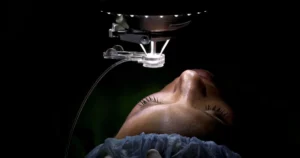Refractive eye surgery has gained immense popularity in recent years as a reliable solution for vision correction. Along with advancements in technology and surgical techniques. However, before considering this life-changing procedure, it’s essential to understand the factors that influence the cost of refractive eye surgery. In this blog, you will get everything you need to understand including the process and aftercare as well.
Contents
What Is Refractive Eye Surgery?
 Refractive eye surgery is a surgical approach that strives to fix typical vision difficulties such as nearsightedness (myopia), farsightedness (hyperopia), and astigmatism. The surgery operates by reshaping the cornea, the translucent front part of the eye, to enhance the way light enters the eye and concentrates on the retina, resulting in clearer vision.
Refractive eye surgery is a surgical approach that strives to fix typical vision difficulties such as nearsightedness (myopia), farsightedness (hyperopia), and astigmatism. The surgery operates by reshaping the cornea, the translucent front part of the eye, to enhance the way light enters the eye and concentrates on the retina, resulting in clearer vision.
During the process, a highly accurate laser removes a slight amount of tissue from the cornea, changing its shape and fixing the refractive error. The surgery is usually fast, often taking less than 30 minutes, and is generally conducted on an outpatient basis. Healing time varies, but most people encounter enhanced vision within a few days to a few weeks. Refractive eye surgery can be a life-changing choice for those who wish to lessen their fixation on glasses or contact lenses and enjoy clearer vision without visual aids.
What Are The Types of Refractive Eye Surgeries and Their Costs?
 There are three types of Refractive Eye Surgeries, and all three are having their own USPs and further advantages, so check them below:
There are three types of Refractive Eye Surgeries, and all three are having their own USPs and further advantages, so check them below:
- LASIK (Laser-Assisted in Situ Keratomileusis): LASIK is one of the most common refractive eye surgeries, offering rapid visual recovery and minimal discomfort. The average cost of LASIK surgery in the United States ranges from Rs. 30,000 – Rs. 80,000 per eye. Prices may vary depending on the factors mentioned earlier.
- PRK (Photorefractive Keratectomy): PRK is an alternative to LASIK and is suitable for individuals with thinner corneas. The moderate charge of PRK surgery is parallel to LASIK, ranging from Rs 25,000 to Rs 1,00,000 per eye. However, the recovery period for PRK is longer compared to LASIK.
- SMILE (Small Incision Lenticule Extraction): SMILE is a newer minimally invasive refractive eye surgery that corrects myopia and astigmatism. This procedure has gained popularity due to its quick recovery time. The cost of SMILE surgery is generally similar to LASIK and PRK, ranging from 50,000 per eye.
Factors Influencing The Cost Of The Surgery?
 Here you can analyze such factors that usually influence Refractive Eye Surgery costs in a certain manner, check them below wisely:
Here you can analyze such factors that usually influence Refractive Eye Surgery costs in a certain manner, check them below wisely:
- Geographic Location: Refractive eye surgery costs can vary significantly depending on your geographic location. Larger cities and regions with higher costs of living often have higher surgical fees. It’s crucial to research and compare prices across different locations to find the best option for your budget.
- Surgeon’s Experience and Reputation: The experience and reputation of the surgeon performing the procedure can influence the cost. Highly skilled and renowned surgeons may charge more for their expertise. However, it’s important to prioritize the surgeon’s qualifications and experience over cost alone when making your decision.
- Technology and Equipment: The technology and equipment used during refractive eye surgery can affect the overall cost. Advanced laser technologies and state-of-the-art equipment often come at a higher price. These technologies, however, can also enhance the precision and safety of the procedure.
- Pre and Post-Operative Care: The expense of refractive eye surgery normally comprises pre and post-operative care, such as consultations, follow-up visits, and prescriptions. Ensure that you have a clear acquaintance of what is formed in the cost and any additional charges that may arise.
What Are The Benefits Of Refractive Eye Surgery?
 Refractive eye surgery offers several advantages for people seeking vision correction:
Refractive eye surgery offers several advantages for people seeking vision correction:
- Improved Vision: The preliminary benefit of refractive eye surgery is sweetened vision without the need for glasses or contact lenses. The surgery desires to update common refractive errors like nearsightedness, farsightedness, and astigmatism, allowing individuals to see more clearly and enjoy better visual acuity.
- Convenience and Freedom: By reducing or eliminating the dependence on visual aids, refractive eye surgery provides convenience and freedom. Activities such as swimming, sports, or simply waking up to clear vision can be enjoyed without the hassle of glasses or contact lenses.
- Enhanced Quality of Life: Clear vision significantly improves the overall quality of life. Individuals can experience increased confidence, improved performance in daily activities, and enhanced enjoyment of hobbies and recreational pursuits.
- Cost Savings: Over time, refractive eye surgery can offer cost savings compared to the ongoing expenses of glasses, contact lenses, and related maintenance and replacements. While the upfront cost of the surgery should be considered, long-term savings can be substantial.
- Quick and Convenient Procedure: Refractive eye surgery is typically performed as an outpatient procedure, usually taking less than 30 minutes. Most individuals experience a relatively quick recovery and improvement in vision within days to weeks.
It’s important to consult with a qualified ophthalmologist or eye surgeon to determine individual candidacy for refractive eye surgery and discuss the potential benefits based on specific needs and expectations.
Risks Of Refractive Eye Surgery?
 While refractive eye surgery is generally safe and effective, like any surgical procedure, it carries some risks and potential complications. Some of the risks associated with refractive eye surgery include:
While refractive eye surgery is generally safe and effective, like any surgical procedure, it carries some risks and potential complications. Some of the risks associated with refractive eye surgery include:
- Dry Eyes: Following the surgery, some individuals may experience temporary or persistent dryness in the eyes, which can cause discomfort and affect vision quality. Lubricating eye drops and other treatments can help manage this condition.
- Overcorrection or under-correction: In some cases, the desired refractive error correction may not be achieved, resulting in overcorrection (making the vision slightly better than intended) or under-correction (leaving some degree of refractive error).
- Visual Disturbances: Certain visual disturbances, such as halos, glare, or double vision, may be experienced, particularly in low-light conditions or at night. These symptoms are usually temporary but can persist in rare cases.
- Infection and Inflammation: Although rare, there is a small risk of developing an infection or inflammation in the eye after surgery. Proper post-operative care and following the surgeon’s instructions can help minimize this risk.
- Flap Complications (for LASIK): LASIK surgery involves creating a thin corneal flap. In rare instances, complications related to the flap creation, such as flap dislocation, epithelial ingrowth, or irregular healing, may occur.
It’s important to note that the overall risk of complications is relatively low, and many individuals achieve significant improvement in their vision with refractive eye surgery. However, it’s crucial to consult with a qualified ophthalmologist or eye surgeon, discuss individual risk factors, and thoroughly understand the potential risks and benefits before making a decision.
Success Rate Of Refractive Eye Surgery
 Refractive eye surgery, such as LASIK, has a high success rate. The success rate can vary depending on factors such as the specific procedure, the surgeon’s experience and skill, and the individual characteristics of the patient’s eyes. Studies have indicated that the success rate of LASIK surgery, one of the most commonly performed refractive eye surgeries, is approximately 95% or higher.
Refractive eye surgery, such as LASIK, has a high success rate. The success rate can vary depending on factors such as the specific procedure, the surgeon’s experience and skill, and the individual characteristics of the patient’s eyes. Studies have indicated that the success rate of LASIK surgery, one of the most commonly performed refractive eye surgeries, is approximately 95% or higher.
This means that the vast majority of patients achieve their desired level of vision correction and experience improved visual acuity without the need for glasses or contact lenses. It’s important to note that success in refractive eye surgery is not solely measured by achieving perfect 20/20 vision. The goal is to provide a significant improvement in visual acuity and reduce the dependence on corrective eyewear.
Conclusion
Refractive eye surgery is a life-changing approach that can enhance your vision and grade of life. Nevertheless, comprehending the elements that influence the price is paramount for making a knowledgeable decision. By considering geographic location, surgeon’s experience, technology, and pre/post-operative care, you can estimate the potential cost of refractive eye surgery. Remember to consult with qualified surgeons, explore insurance coverage options, and consider financing plans to make the procedure more affordable. With proper research and planning, you can embark on the journey to a clear and unaided vision.
Lasik surgery is a safe 10-minute procedure to help you get rid of glasses. EyeMantra offers the most advanced LASIK options including PRK, Femto Lasik, SMILE surgery, Standard LASIK, ICL, and Contoura vision. If you have any questions on Lasik surgery in Delhi, Lasik surgery cost, and Lasik procedure, call us at 9711116605 or email at [email protected].


